Definition of Dandruff
Dandruff is a common scalp condition, characterised by scaling of the skin on the scalp. Although dandruff can cause itching of the scalp, not all itching in the scalp are due to dandruff.
Definition of Fungal Infection of Scalp
Fungal infection of the scalp is commonly called tinea capitis or ringworm of the scalp. This is a superficial fungal infection (dermatophytosis) of the scalp hair follicle with hair shaft involvement. It is caused by fungal species in the genera Microsporum and Trichophyton.
Is dandruff a fungal infection?
Dandruff is not a fungal infection. It is generally believed that dandruff represents nothing more than physiologic scaling of the scalp. Dandruff is non-contagious. However, the condition is most often associated with a yeast-like fungus called Malassezia, the most prevalent being M. restricta and M. globosa (Gemmer et al,2002). These fungal organisms are part of normal skin flora feeding on skin oils on the scalp. The fungus does not cause any problems on the scalps of most healthy individuals. There is a higher population density of Malassezia yeast on the scalps of those with dandruff than those without dandruff, suggesting a role of Malassezia yeasts in triggering excessive shredding of skin scales on the scalp. More studies are needed to provide a better understanding of the pathophysiological role of Malassezia in the dandruff condition in some individuals.
Some host factors that contribute to dandruff are :
- Genetic predisposition –dandruff tends to run in families
- Emotional component – endocrine Human source such as hormonal changes and neurological mediated factors such as emotional stress
- Changes in quantity and composition of sebum – oily scalp
- Certain illnesses – Patients with Parkinson’s disease, AIDS patient with weakened immune system
Types of fungus infecting scalp
There are two (2) genera of dermatophytes that can infect the scalp
- Common Microsporum species
- canis
- audouinii
- Common Trichophyton species
- schoenleinii
- tonsurans
Parasitic patterns of hair involvement by dermatophytes
There are generally 2 types of parasitic hair infection by dermatophytes. They are:
- endothrix : Invasion of fungal elements with mainly arthrospores (broken-up hypae) inside the hair shaft
- endo-ectothrix : Invasion of hyphae inside the hair shaft with arthrospores and/or hyphae surrounding the hair shaft. This type of hair invasion is sometimes known as ectothrix infection eg. Microsporum canis
Ringworm of scalp caused by Microsporum canis
Microsporum canis causes gray patch tinea capitis. It is an ectothrix infection of the hair. Arthrospores (fungal spores) form a sheath around the hair shaft.
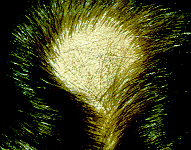 |
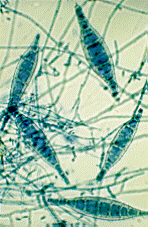 |
|
Tinea capitis showing extensive hair loss caused by M.canis (Reference: Dr David Ellis,www.mycologyonline.adelaide.edu.au) |
Microscopic view of a culture of Microsporum canis
(Reference: Dr David Ellis,www.mycologyonline.adelaide.edu.au) |
Ringworm of scalp caused by Trichophyton tonsurans
Trichophyton tonsurans causes black dot tinea capitis . Endothrix infection of hair causes the shaft to break off at or below the surface of the scalp. Arthrospores are seen within the hair shaft.
 |
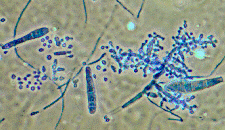 |
| Endotrix tinea capitis caused by T. tonsurans
(Reference: Dr David Ellis,www.mycologyonline.adelaide.edu.au) |
Microscopic view of a culture of T.tonsurans
(Reference: Dr David Ellis,www.mycologyonline.adelaide.edu.au) |
Ringworm of scalp caused by Trichophyton schoenleinii
Causes favus infections of hair. Thick yellow crusts form within the hair follicles and are composed of hyphae. Infection can result in alopecia
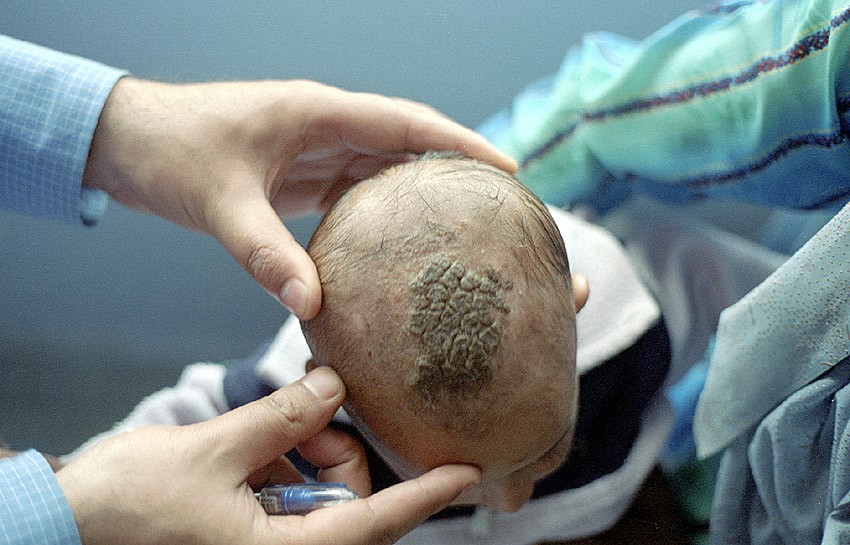 |
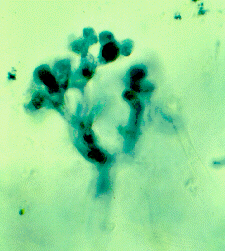 |
|
A child with favus infection caused by T. schoenleinii (Reference : Paul La Porte, wikipedia organization) |
Microscopic view of T.schoenleinii ‘Favic chandeliers’
(Reference: Dr David Ellis,www.mycologyonline.adelaide.edu.au) |
To Control of Fungal Infection on the Scalp:
- Consult a dermatologist for treatment
- Practice personal hygiene.
- Do not sharetowelsandcombs.
References
- Clinical Mycology, by William E. Dismukes, Peter G. Pappas, Jack D. Sobel, edition 2003.
- Clinical Microbiology and Infectious Diseases, by W. John Spicer, 2nd edition.
- Dr David Ellis of University Adelaide, Australia(mycologyonline.adelaide.edu.au)
- Gemmer, et al(2002). Fast, Noninvasive Method for Molecular Detection and Differentiation of Malassezia Yeast Species on Human Skin and Application of the Methoo Dandruff Microbiology. Journal of Clinical Microbiology 40 (9): 3350–3357.
| Last Reviewed | : | 3 March 2017 |
| Writer | : | Kamaladevi a/p K.Subramaniam |
| Translator | : | Kamaladevi a/p K.Subramaniam |
| Accreditor | : | Keah Kwee Choo |







